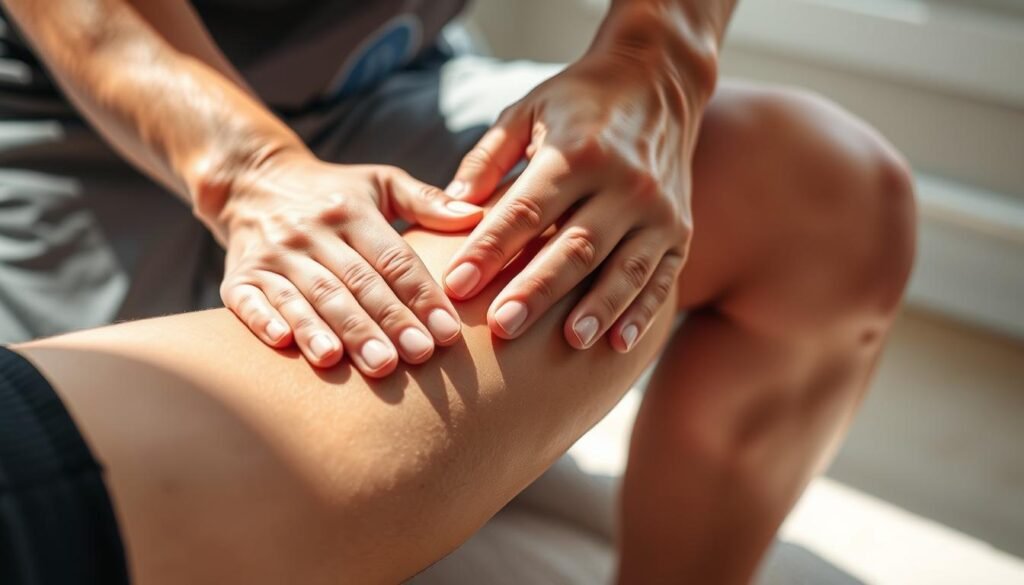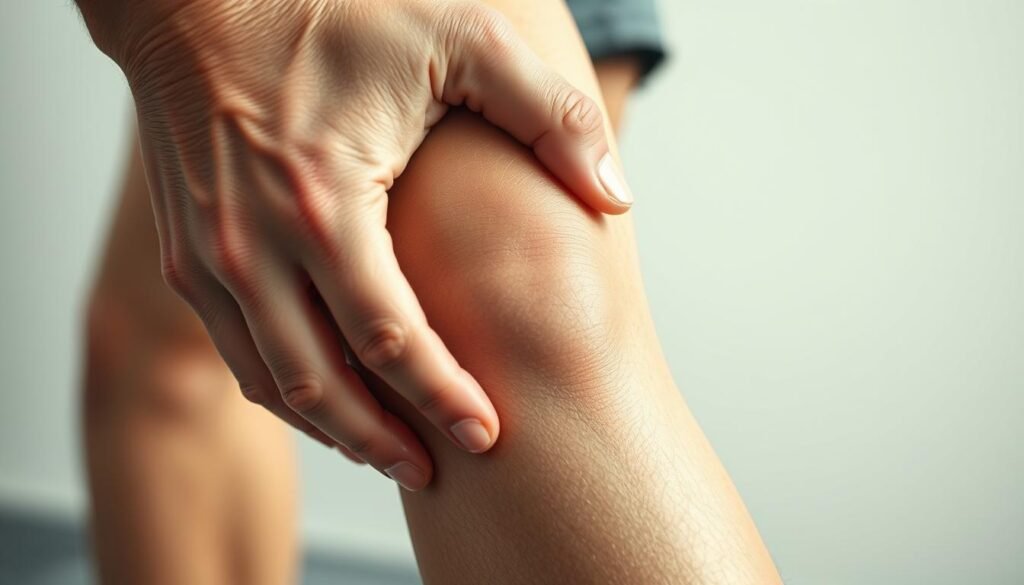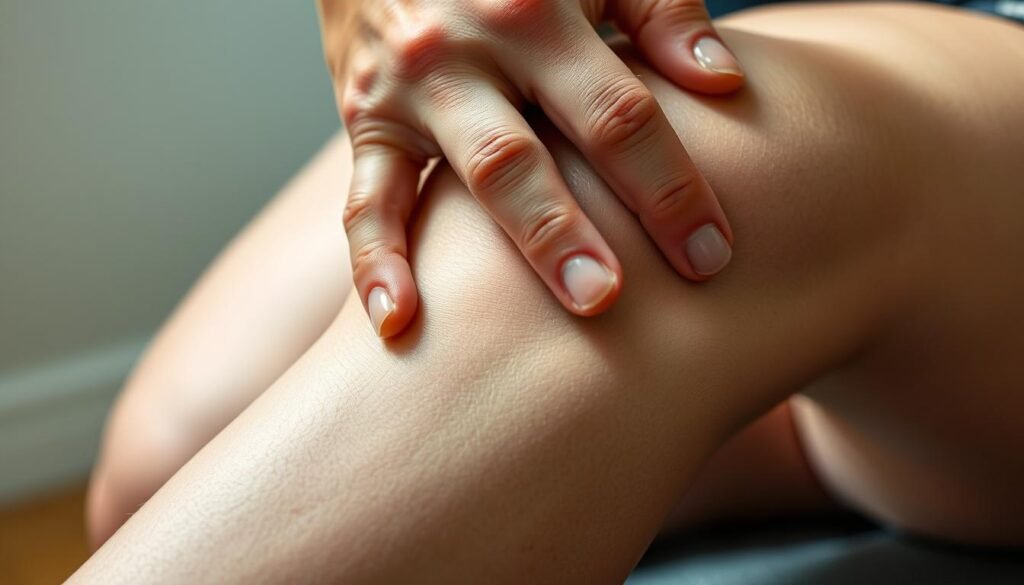
Are you struggling to recover from a knee injury? Medial Collateral Ligament (MCL) sprains are common and can significantly impact mobility and quality of life.
We will explore how massage techniques can aid in the recovery process. They reduce pain, improve circulation, and enhance flexibility.
In this article, we will discuss various massage methods and taping techniques. These can help alleviate the discomfort associated with MCL sprains.
Key Takeaways
- Understanding MCL sprains and their impact on mobility
- The role of massage in the recovery process
- Various massage techniques for alleviating discomfort
- Taping methods to support the knee during recovery
- Improving circulation and flexibility through massage
Understanding MCL Sprains
For athletes and those who love physical activities, knowing about MCL sprains is key. The medial collateral ligament (MCL) is vital for knee stability. It’s often injured in sports.
What is the MCL?
The MCL connects the femur to the tibia on the knee’s inner side. It keeps the knee stable. A healthy MCL is key for normal knee function. It lets us move our knees freely while keeping them stable during activities.
Common Causes of MCL Sprains
MCL sprains happen from sports injuries, direct hits to the knee, or sudden twists. Athletes in contact sports like football, soccer, and hockey are at high risk. The ligament can stretch or tear when the knee bends inward or twists.
Symptoms We Should Look For
Symptoms include pain on the knee’s inner side, swelling, and feeling unstable. In bad cases, the knee might feel like it’s giving way. Spotting these symptoms early is key for the right treatment. If you notice them, get medical help to avoid more harm.
In summary, knowing about MCL sprains and their symptoms is crucial for recovery. Recognizing signs early and getting the right sports injury therapy helps in a faster and better recovery.
Benefits of Massage for MCL Sprains
Massage therapy is key in healing MCL sprains. It offers many benefits that help in the recovery process.
Pain and Swelling Reduction
Massage is great for reducing pain and swelling from MCL sprains. It uses gentle pressure to relax the area and lower inflammation. This makes it a big part of physical therapy for MCL sprain.
Improving Circulation
Massage also boosts blood flow, which is essential for healing. Better circulation means more nutrients reach the injured area. This is crucial for knee rehabilitation exercises to heal well.
Enhancing Flexibility
Massage also makes the knee more flexible and mobile. It helps keep the knee moving well, which is key for a full recovery.
| Benefits | Description |
|---|---|
| Reducing Pain and Swelling | Massage promotes relaxation and reduces inflammation. |
| Improving Blood Circulation | Enhanced circulation aids in the delivery of nutrients to the injured area. |
| Enhancing Flexibility | Regular massage reduces stiffness and improves knee mobility. |
Knowing how massage helps with MCL sprains can guide recovery plans. It’s a vital part of a complete treatment, helping achieve a successful recovery.
Massage Techniques for MCL Sprains
Massage therapy is key in treating MCL sprains. It helps reduce pain, swelling, and improves movement. Specific techniques can make a big difference in recovery.
Gentle Warm-Up Techniques
Start with gentle exercises to warm up the knee. Light stroking and circular motions boost blood flow. This makes the area ready for deeper massage.
These warm-ups reduce stiffness and get muscles ready for deeper therapy. This makes the treatment more effective.

Specific Strokes for the MCL Area
After warming up, use specific strokes on the MCL. Deep tissue massage and cross-friction massage are great. They help break down scar tissue and heal the ligament.
These methods can greatly reduce pain and swelling. They help the knee heal faster.
Trigger Point Therapy for Relief
Trigger point therapy is also helpful for MCL sprains. It targets specific points to ease pain and muscle tension. It’s good for pain felt in other areas too.
Adding trigger point therapy to your routine can help manage pain better. It tackles both direct and referred pain from MCL sprains.
How to Incorporate Massage into Recovery
Massage therapy is key in recovering from MCL sprains. It helps reduce pain and boosts knee function. This makes it a crucial part of the healing process.
Frequency and Duration of Massage
The number and length of massage sessions vary with the sprain’s severity. For minor sprains, you might need 2-3 massages a week. More serious cases might require daily sessions, under a therapist’s advice.
Key considerations for massage frequency:
- Mild sprains: 2-3 times a week
- Moderate sprains: 3-4 times a week
- Severe sprains: daily or as recommended by a therapist
Combining Massage with Other Treatments
Using massage with other treatments can speed up recovery. This includes physical therapy, bracing, and exercises. Together, they can make your knee stronger and more mobile.
Benefits of combining treatments:
- Enhanced pain relief
- Improved knee function and mobility
- Faster recovery times

When to Consult a Professional
If pain doesn’t go away or gets worse, see a pro. A healthcare expert or a licensed massage therapist can tailor a treatment plan. This ensures your recovery is safe and effective.
Signs that require professional consultation:
- Persistent or worsening pain
- Increased swelling or bruising
- Instability or weakness in the knee
Taping Techniques for MCL Sprains
Taping can be a big help when you have an MCL sprain. It’s a common method in sports injury therapy that keeps the knee stable. This helps prevent more injuries.
Materials Needed for Taping
To tape an MCL sprain, you need a few things. You’ll need kinesiology tape, which is flexible and strong. It lets you move freely. You also need scissors to cut the tape right. And some pre-tape spray or adherent to make the tape stick better.
Step-by-Step Taping Guide
Here’s how to tape your knee:
- First, clean and dry your skin. Then, apply pre-tape spray or adherent to help the tape stick.
- Cut a piece of kinesiology tape to the right length.
- Put the tape on with the right amount of pressure. Start at the bottom of the knee and go up. Make sure it’s not too tight, as it can cut off blood flow.
- Smooth out any wrinkles or air bubbles to make sure the tape is flat against your skin.
Experts say, “Proper taping can really help with recovery. It gives extra support to the injured ligament.”
Proper taping techniques are key for the best ligament sprain recovery.
Tips for Effective Taping
To tape well, avoid common mistakes. Don’t make the tape too tight, as it can block blood flow. Also, watch for any skin irritation or allergic reactions to the tape or pre-tape spray.
By following these tips, we can use taping as part of our sports injury therapy. It helps keep our knee healthy while we recover from an MCL sprain.
Conclusion: Empowering Our Recovery Journey
Understanding how to heal from MCL sprains is crucial. We can use massage, taping, and physical therapy to manage knee pain. These methods help improve our knee health.
Key Takeaways
Massage therapy reduces pain and swelling, boosts blood flow, and increases flexibility. Taping provides support and stability to the knee. For more help, physical therapy for knee pain resources are out there.
Consistent Care for Optimal Recovery
Being consistent is vital for recovery. Regular exercises and the techniques we’ve learned empower our journey. This approach helps us get back to normal activities safely and confidently.
